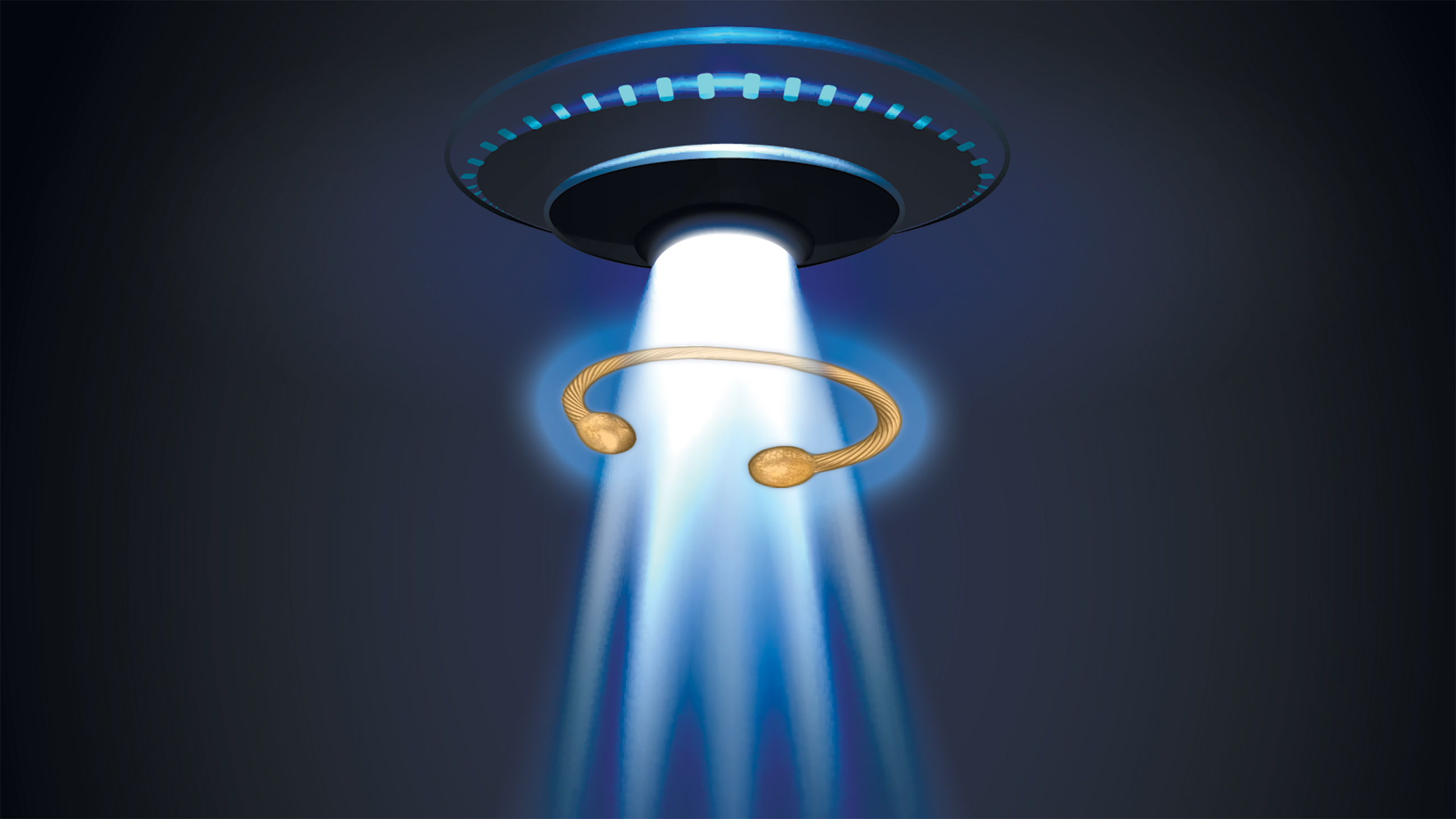Are you suffering from persistent, prolonged and debilitating pain? Does sciatica, or headache pain keep you trapped in your house, unable to live the life you always dreamed of?

WHAT I LEFT OUT is a recurring feature in which book authors are invited to share anecdotes and narratives that, for whatever reason, did not make it into their final manuscripts. In this installment, author Erik Vance shares a story that didn’t make it into his latest book “Suggestible You: The Curious Science of Your Brain’s Ability to Deceive, Transform, and Heal.”
Despair no more, dear reader, help is available through cutting edge, ionized steel technology. The same technology used on the space shuttle, on the Mars rover and in the Large Hadron Collider that revealed the existence of the elusive “God particle.” It’s the latest, and yet also the oldest — the same technology used to cure tens of millions of people across the world through the ancient healing practice of acupuncture.
What is this miracle scientific breakthrough, you ask? Why, it’s the Q-Ray Ionized Bracelet! A stunning and stylish device with secret ionizing technology specifically designed to harness the power of ancient Chinese wisdom and cure your pain. The bracelet taps into the energy channels in your wrist, putting healing ionized particles into your body and balancing out the negative energy coursing through.
Still not sure? Let’s bring on a real live scientist — Dr. James Christiansen, Ph.D. — who did a series of experiments on this amazing ionizing device. He used an infrared thermographic imaging device to measure the skin of a person wearing the Q-Ray Ionized Bracelet. Without the bracelet, the patient’s skin was red and painful. But look! As soon as the bracelet touches the skin, the pain is gone, along with the heat. Science!
“Doctor, are these infrared machines reliable?”
Dr. Christiansen: “Very true, very accurate, very reliable.”
More or less, that was the sales pitch through the late 1990s and early 2000s for the hugely successful Q-Ray bracelet, marketed mostly on late night cable television and through 30-minute infomercials. Essentially, the company claimed that it had specially treated various metals so that they could release charged particles called “Q-rays” into your skin that would cancel out the negative energy causing you pain.
It was a fun, science-fictiony idea that sounded vaguely plausible. Unfortunately, from a real science perspective it was total bunk. There are no such things as Q-rays. Ionization is simply the process of adding a positive or negative charge to a material (usually by heating it up to excite the electrons and then luring them away with a positively charged source) that only lasts a couple minutes at best. And even if you ionized a bracelet, it wouldn’t release anything on your skin.
In reality, the only magic involved in Q-Ray was the magic of placebo; the potency of beliefs to trigger physiological changes in the body. In that sense, the commercials were right about one thing — the power of Q-Ray was tied to both ancient mysticism and cutting-edge science. From Aristotle to Franz Mesmer to doctors on the battlefields of World War II, belief has a funny way of creeping into medicine when we least expect it to. Whether you call them alternative medicine practitioners, shamans, or charlatans, there have always been people adept at harnessing these beliefs.
The magical Q-Ray bracelet is still being sold today.
But my favorite example is still Q-Ray, for a few reasons. First, you just have to respect the moxie. Placebos are all about storytelling — finding a method to trigger what psychologists call expectation. Most online scams rely on either the mysteries of ancient wisdom or the mysteries of modern science to capture our imagination. But Q-Ray used both. Also, I like that company founder Andrew Q. Park — a born-again Christian whose product harnessed the Buddhist concept of qi — named the company QT Inc. He literally named his company something you say when you are trying to pull a fast one (and did not respond to multiple attempts to get comment for this article).
Second, the company got caught. The Federal Trade Commission is a public office tasked with protecting American consumers by, in their words, “stopping unfair, deceptive, or fraudulent practices in the marketplace,” and it has an impressive record of attacking liars and false advertisers of all stripes over the years. Bogus credit line offers, fake “work from home” scams, and slippery car dealership ads, the FTC goes after all of them. But the office has a special dislike for snake oil salesmen.
Their work gets little notice and their victories even less. If you are a fan of pomegranate juice by the company Pom, you might have noticed they once claimed it treats prostate cancer but no longer do. That’s because they quietly changed their advertising after stupendously losing a case against the FTC.
Mary Engle, associate director of the FTC’s Division of Advertising Practices, says of the seemingly infinite number of health scams on the market, the FTC can only prosecute five or 10 per year so they focus on the most egregious or dangerous claims. In 2003, they turned their attention to Q-Ray.
Although Q-Ray never revealed the secret of its magical ionizing manufacturing process (but over the lengthy trial, Park admitted he chose the word “ionizing” mostly because Polaroid blocked him from calling them “polarized”) it didn’t take long for the FTC to prove they were just normal stainless steel bracelets. A team at the Mayo Clinic in Florida even tested the bracelets against a placebo bracelet and unsurprisingly found they were the same.
Throughout the case, the makers of Q-Ray did everything they could to obfuscate, hide and misdirect. First they said that the bracelets worked but they couldn’t say how. Then they tried to hide behind the mystery of traditional Chinese medicine. Finally, it became clear that their product was nothing more than a well-marketed placebo.
So they took an interesting legal gamble, which is my very favorite part of this story. Finally, with their backs to the wall they said, yes, the bracelet may be a placebo. But placebos work. Thus, they weren’t lying — their product could indeed cure chronic pain. In some people.
Because a placebo is inert, they argued, the only power it has is from the power of “consumer expectations.” And since all of those expectations were created by QT Inc., all the healing power of the $200 bracelet (which cost maybe $10 to make) should be attributed to the company. The extra money customers paid was for the expensive work of deceiving them.
“The defendants were arguing ‘Well, look, people experienced pain relief. That should be good enough,’” Engle says. “The court said you don’t get to lie to people even if you claim it’s for their own good.”
It was a bold move that, in the end, didn’t impress the federal district court in Chicago or the Seventh Circuit of Appeals. Q-ray was forced to pay back the estimated $22.5 million in profits plus as much as $87 million in refunds. In the final decision, the sassy presiding judge, Frank Easterbrook, wrote, “Since the placebo effect can be obtained from sugar pills, charging $200 for a device that is represented as a miracle cure but works no better than a dummy pill is a form of fraud.” And then, with a clear sense of impish glee, “Defendants might as well have said: ‘Beneficent creatures from the 17th Dimension use this bracelet as a beacon to locate people who need pain relief, and whisk them off to their homeworld every night to provide help in ways unknown to our science.’”
It was probably the first and last time that alien creatures from the 17th Dimension have been cited in legal precedence. Easterbrook also noted that the Mayo Clinic had found no difference between the ionized bracelet and a dummy one. Thus, the only reason this placebo worked was because of the deception in the infomercials. And deception in advertising is fraud.
But what nobody bothered to mention was that Q-Ray did have some legitimate points to make. Sure, the bracelets worked no better than a placebo. But both eased the pain in more than 70 percent of the people tested. That response rate would be respectable even for some of the best drugs on the market. You can almost hear the amazement in the Mayo Clinic’s published paper on the experiment. “Although the goal of our study was not to assess the effectiveness of placebos, our results supported the benefits of using placebos to treat pain.”
There’s no doubt that the makers of Q-Ray bracelets were charlatans scamming their clients. But man, they were really good at it. To understand how good, I tracked down James Christiansen, the scientist who appeared in Q-Ray’s promotional videos. It turns out he wasn’t an actor hired to play a scientist but rather a real person with a real Ph.D. He’s a retired researcher and chiropractor, though at the National University of Health Sciences in Lombard, Illinois, a private school that offers degrees including naturopathic medicine, acupuncture, and oriental medicine.
“If you watch the commercial very carefully, I never say that their [bracelet] did it,” he says. “I didn’t want to be promoting an instrument that didn’t work.”
Christiansen is a sweet fellow with the soft, faltering voice that you could imagine belonging to someone who spends long hours in the laboratory. He said QT approached him in the middle of their legal troubles hoping he would provide them with evidence they could use in court. They offered him a chance to use a thermal imaging device to measure the body’s response to their bracelets. Chiropractors like him don’t get a lot of research grants and he was under the impression that afterwards he would be able to keep the device.
So they brought in a subject with chronic pain who regularly uses Q-Ray bracelets but hadn’t worn one it a month or so. As soon as he put on the bracelet, the pain decreased, as did the temperature in his skin. That was the measurement that Christiansen claimed was so reliable in the late-night advertisements later quoted in court documents.
However, when he tried the same thing with people who had never worn the bracelet and had no expectations for it, he found it was no better than a placebo. So, in fact, the drop in pain and change in skin temperature were not caused by the ionized metal but by conditioning from the minds of the people wearing them. As for Christiansen, he says the company took back their machine but gave him a bunch of free bracelets instead.
“I have 20 of them around here and I wear them all the time. None of them work. I don’t notice a damn thing when I wear them,” he says. “And yet I see other people out in society wearing them and if you ask they say, ‘Oh yeah, I wouldn’t be without it.’ And to me that might just happen to be a person who is susceptible to that placebo. And I am not saying that being susceptible to a placebo is a bad thing.”
Erik Vance has written for The New York Times, Nature, Scientific American, Harper’s, and National Geographic, among other publications. His book, “Suggestible You,” was supported in part by the Pulitzer Center on Crisis Reporting.










